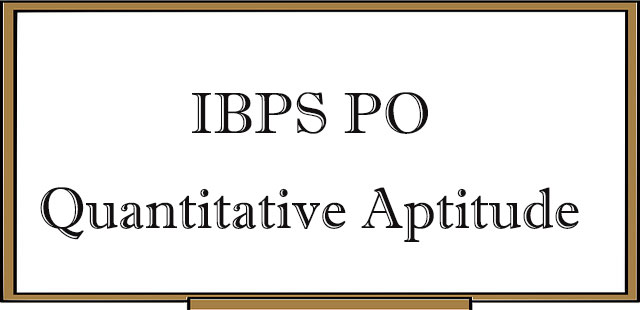-
IBPS PO Exam - Quantitative Aptitude Preparation Tips and Syllabus
Updated : 30-Oct-2017
The Prelims exam consists of three sections from which Quantitative Aptitude section for IBPS PO is the most crucial one, as this section can be scoring for some while some might face difficulty in crossing the sectional cut-off even and is very less theoretical. This section of IBPS PO exam comprises of 35 questions in the question paper where one mark is awarded for every right answer, and 0.25 is deducted for any wrong answer.
IBPS PO Quantitative Aptitude - Syllabus and how to prepare it:
- Number Series- there are a total of five questions that are consist in the exam. It includes equations in which a series of number is given in a sequence which is estimated to follow a pattern and all we have to do is figure out that pattern and completes the series given in the question. Two types of questions are observed as a series is given with a missing number in between the series. To find the missing number we need to figure out the set as the whole series must be following some pattern.
- Simplification/Approximation- This topic comprises of 5 questions in the exam paper. To solve a complex problem and simplify it to the last is known as simplification. This topic is held in the exam so that there are no doubts or issues with the calculations of the candidate. There are various types of questions that are included in this topic, but mainly two types are focused which includes questions like when an estimate is given with a missing number, and we have to approximate the missing number and find its value. Another type includes questions in which long count is given with signs, and we have to calculate the answer which is very simple and easy if attention is paid. This question was asked in Quantitative Aptitude IBPS PO Mains.
- Quadratic Equation- in the question paper, this topic comprises of 5 marks. Mostly, the type of question in which students fail to answer is in which two linear equations are given and the aspirants have o find the value of x and y. While sometimes quadratic equations regarding x and regarding y are given and to get a result which is interlinked and we need to solve both the equations.
- Miscellaneous Questions- This part comprises of a total of 10 questions. It includes topics like Profit and Loss, Time & Work, Ratio & Proportion, Simple interest & Compound Interest, Boats & Streams, Average, Probability and Speed, Distance, Time, etc. Students must be very aware while preparing for these types of questions as the variety of questions asked is very vast. These questions are relatively based on 10th class math, and a student just needs to go all the basic formulas and concepts to prepare for this section. This section is one of the most important sections of Quantitative Aptitude of IBPS PO.
- Data Interpretation- This part of the quant section which is quite time-to consume so the student need to learn how to manage time. Various questions are presented to test the speed of calculations and mention given data in tables, charts, etc. So to master this topic, one should read the given data carefully and then answer the questions asked. The most important thing is to go through all the minute details of that question or figure and then respond to the question try not taking any chance in it because it might cost you. The data mentioned is estimated to be displayed in the form of pie-chart, line chart, bar chart, tabular form, etc.
No. of Questions Asked
Topic
05
Simplification
05
Approximation
10
Data Interpretation
05
Number Series
05
Inequality
10
Miscellaneous (Profit & Loss, Boats and Streams, Averages, Time & Work, CI & SI, Ratio & Proportion, Partnership & Percentage)
Strategies to Prepare for Quantitative Aptitude in IBPS PO:
- Initiate with Number System: Start your preparation number system as it requires consistency and practice. Try to give time to all the questions under this topic as this includes in-depth calculation. Refer to NCERT 10th books in case of difficulty
- Learn Factorials, Cubes, and Squares: These are the basic tips and tricks or shortcut techniques for squares, cubes, square root, cube root, factorials, and multiplication. To set a command over this you need to learn tables from one to twenty along with Squares and Cubes from one to thirty. This will eventually help you in saving a lot of time and reduce the unnecessarily wasted time. This will help you in attaining an extra edge over other topics.
- Distribution of Time: It is a crucial element as it can lead you to success and can even be a drawback. Try using shortcut techniques and tricks to cover the whole section but in case you are not sure how to use the trick or shortcut, do not apply the trick on that question and try to do it a simpler way. Practice more and more to speed up your calculation part.
- Access and Analyze Yourself: Solve as many number of question papers as possible. Take mock tests from time to time and while solving these papers remember to monitor or keep a check on the time you take to spend on every question or collectively on the whole topic as they will help you to manage time. Try to fix and strengthen your weak points, as these tests will help you in analyzing your true status or position of preparation.
Hope you found all the necessary information on IBPS QUANTITATIVE PO EXAM and If you have any queries, suggestions, complaints or question please mention them in the comment section and we will try to resolve them to make you aware of all the queries. To keep yourself updated, check more articles on our website.
